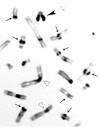Clinical Description
ESCO2 spectrum disorder is characterized by mild-to-severe prenatal growth restriction, limb malformations (which can include bilateral symmetric tetraphocomelia or hypomelia caused by mesomelic shortening), hand anomalies, multiple joint contractures, craniofacial abnormalities, and often corneal opacities. Intellectual disability is common.
To date 150 individuals have been identified with ESCO2 spectrum disorder [Ismail et al 2016]. The following description of the phenotypic features associated with this condition is based on that report and on Vega et al [2010] and Vega et al [2016].
Table 2.
Select Clinical Features of ESCO2 Spectrum Disorder
View in own window
| Feature | Proportion of Individuals w/Feature 1 | Comment |
|---|
| Growth deficiency | 49/49 (100%) | |
| Microcephaly | 38/40 (95%) | |
| Phocomelia | 53/53 (100%) |
|
| Bone fusions | 15/23 (65%) | Knees, ankles, wrists, elbows, talipes equinovarus, syndactyly (18%) Flexion contractures (16%)
|
| Cleft lip & palate | 29/48 (56%) | Cleft palate only (5%) |
| DD/ID | 23/38 (61%) | |
Ocular
abnormalities | (37%) | Corneal opacities (33%) Microphthalmia (8%) Nystagmus (8%) Glaucoma (8%)
|
Urogenital
anomalies | 14/30 (48%) | Cryptorchidism (22%) Enlarged phallus (33%) Enlarged clitoris (45%)
|
| Renal anomalies | 1/8 (12%) | Polycystic kidney; horseshoe kidney |
| Cardiac anomalies | 10/34 (29%) | ASD, VSD |
ASD = atrial septal defect; DD/ID = developmental delay / intellectual disability; VSD = ventricular septal defect
- 1.
Numerator = number of individuals with the feature; denominator = number of individuals with information on the feature.
Growth restriction of prenatal onset is the most consistent finding in all affected individuals. Postnatal growth restriction can be moderate to severe and correlates with the severity of the limb and craniofacial malformations.
Limb malformations include symmetric mesomelic shortening and anterior-posterior axis involvement in which the frequency and degree of involvement of long bones is, in decreasing order:
Upper limbs. Radii, ulnae, and humeri in the upper limbs;
Lower limbs: Fibulae, tibiae, and femur.
The degree of limb abnormality follows a cephalo-caudal pattern: the upper limbs are more severely affected than the lower, with several cases of upper limb-only malformations.
Hand malformations include brachydactyly and oligodactyly. The thumb is most often affected by proximal positioning or digitalization, hypoplasia, or agenesis. The fifth finger is the next most affected digit with clinodactyly, hypoplasia, or agenesis. In those with severe involvement, only three fingers are present (and rarely, only one finger).
Limb bone fusions, evident in individuals with mild phocomelia, are more common in the knees and ankles, although also present in hands.
Craniofacial abnormalities include: cleft lip and/or cleft palate, premaxillary prominence, micrognathia (77%), microcephaly, brachycephaly (63%), midfacial capillary hemangioma (71%), malar flattening (88%), downslanted palpebral fissures (57%), widely spaced eyes (85%), exophthalmos resulting from shallow orbits (59%), corneal opacities (33%), underdeveloped ala nasi (77%), convex nasal ridge, and ear malformations (69%).
Mildly affected individuals have no palatal abnormalities or only a high-arched palate. The most severely affected individuals have fronto-ethmoid-nasal-maxillary encephalocele.
Correlation between the degree of limb and facial involvement is observed: individuals with mild limb abnormalities also have mild craniofacial malformations, whereas those with severely affected limbs have extensive craniofacial abnormalities.
Intellectual disability is present in the majority of affected individuals; normal intellectual and social development have also been reported [Petrinelli et al 1984, Stanley et al 1988, Maserati et al 1991, Holden et al 1992].
Other findings that may be observed:
Abnormal genitalia
Renal anomalies. Polycystic kidney (2%), horseshoe kidney, hydronephrosis (2%)
Heart defects. Atrial septal defect, ventricular septal defect, patent ductus arteriosus
Eye abnormalities. Commonly, corneal opacities with occasional involvement of the crystalline lens; other ocular findings include microphthalmia and glaucoma [
Ismail et al 2016].
Hair. Sparse hair, silvery blonde scalp hair
Prognosis. Little is known about the natural history of ESCO2 spectrum disorder. Wide clinical variability is observed among affected individuals, including sibs. The prognosis depends on the malformations present: the severity of manifestations correlates with survival. Mortality is high among most of the severely affected pregnancies and newborns. Mildly affected children are more likely to survive to adulthood.
The cause of death has not been reported for most affected individuals. Reported causes are infection (5 individuals), aneurysm/hemorrhage (3 individuals), and malignancy (3 individuals) [Herrmann & Opitz 1977, Vega et al 2010]. Perinatal mortality is correlated with severity of the malformations; early death is usually secondary to respiratory complications and infection [Van Den Berg & Francke 1993].
Nomenclature
In 1919, John B Roberts reported phocomelia, bilateral cleft lip and cleft palate, and protrusion of the intermaxillary region in three children of an Italian couple who were first cousins [Roberts 1919].
In 1969, J Herrmann and colleagues described a syndrome of intrauterine and postnatal growth retardation, mild symmetric reduction of the limbs, flexion contractures of various joints, multiple minor anomalies (including capillary hemangiomas of the face, cloudy corneas, hypoplastic cartilages of the ears and nose, micrognathia, and scanty, silvery-blond hair), and autosomal recessive inheritance. They named this condition the pseudothalidomide or SC syndrome (for the initials of the surnames of the 2 families described) [Herrmann et al 1969].
Clinical evidence that these two phenotypes are allelic was supported by the observations that both were caused by biallelic pathogenic variants in ESCO2 [Schüle et al 2005, Vega et al 2005].
Other synonyms used for Roberts syndrome in the past are Appelt-Gerken-Lenz syndrome, hypomelia-hypotrichosis-facial hemangioma syndrome, tetraphocomelia-cleft palate syndrome, and pseudothalidomide syndrome.


